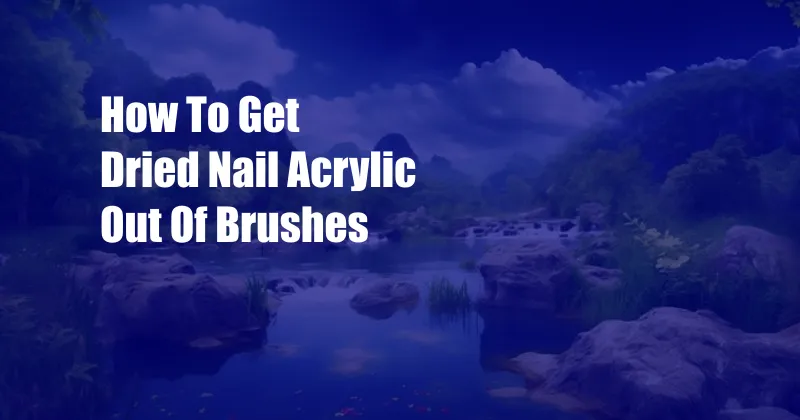
How to Effortlessly Remove Dried Acrylic From Your Nail Brushes
Nail acrylics, a popular choice for creating durable and stunning nail art, can lead to a messy cleanup when not handled properly. Dried acrylic on nail brushes becomes a common problem, making it challenging to keep your essential tools clean and ready for the next use. But fear not! In this comprehensive guide, we’ll explore effective methods and provide expert advice on how to dissolve and remove dried acrylic from your nail brushes efficiently.
The Persistent Problem: Dried Acrylic on Nail Brushes
Acrylics, a mixture of liquid monomer and acrylic powder, harden when exposed to air, forming a durable layer on your nails. However, when used on nail brushes, the same hardening process can create an unwanted residue, making them stiff and difficult to clean. The dried acrylic can clog the bristles, preventing proper application and compromising the brush’s lifespan.
Understanding Nail Acrylics for Effective Removal
To combat this issue, it’s essential to understand the properties of nail acrylics. The monomer component is a volatile liquid that evaporates as the acrylic hardens, leaving behind a polymer network composed of acrylic chains. This polymer network creates the durable structure we desire on our nails but can also adhere tenaciously to surfaces like nail brushes.
Methods for Dissolving and Removing Dried Acrylic from Nail Brushes
Now that we have a better understanding of the nature of dried acrylic, let’s delve into the practical methods to remove it from your nail brushes:
1. Acetone Soaking:
- Acetone, a powerful solvent, is a tried-and-tested method for dissolving dried acrylic.
- Submerge the affected brushes in a container filled with acetone.
- Allow them to soak for several hours or overnight, depending on the extent of the dried acrylic.
- Use a soft cloth or brush to gently loosen any remaining residue after soaking.
2. Isopropyl Alcohol:
- Isopropyl alcohol, though not as potent as acetone, can also be effective in dissolving dried acrylic.
- Similar to the acetone method, soak your brushes in isopropyl alcohol for an extended period.
- This method might require repeated soaking and brushing for optimal results.
Tips and Expert Advice for Hassle-Free Removal:
- Always wear gloves and work in a well-ventilated area when handling solvents like acetone or isopropyl alcohol.
- Avoid using harsh chemicals that can damage the bristles of your nail brushes.
- If the dried acrylic is particularly thick or stubborn, consider using a nail brush cleaner specifically designed to dissolve acrylics.
- Rinse the brushes thoroughly with warm water and soap after cleaning to remove any residual solvents.
- Store brushes vertically to prevent bristles from bending and deforming.
Frequently Asked Questions (FAQ) on Removing Dried Acrylic from Nail Brushes
Q: Can I reuse the acetone or isopropyl alcohol after cleaning my brushes?
A: No, it’s not recommended to reuse solvents as they become saturated with dissolved acrylic and less effective over time.
Q: How often should I clean my nail brushes to prevent dried acrylic buildup?
A: Regular cleaning is crucial to maintain brush hygiene and performance. Clean your brushes after every use or at least once a week to prevent acrylic accumulation.
Conclusion: A Clean Canvas for Nail Art Perfection
Mastering the art of removing dried acrylic from nail brushes is essential to maintain the longevity and performance of your tools. The methods and advice outlined in this article empower you with the knowledge and techniques to tackle this common challenge effectively.
So, let us know, are you ready to bid farewell to dried acrylic buildup and embrace clean, pristine nail brushes? Get those bristles sparkling clean and unleash your creativity on the canvas of your nails!